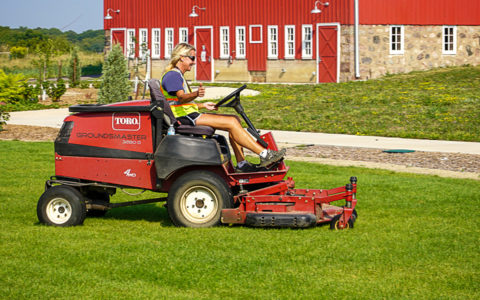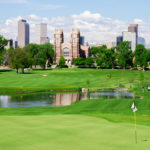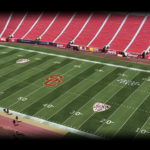Iconic Grounds: Biltmore
This article is part of a series featuring premier facilities across North America that partner with Toro for equipment and support.
What does the expansive Biltmore in Asheville, North Carolina, and Central Park in New York City have in common? Both grounds were designed by the “Father of Landscape Architecture in America” — Frederick Law Olmsted. More than 130 years after Olmsted first took in the mountain views from the future home of George W. Vanderbilt, his vision remains the guiding principle for the estate’s landscaping.
For this Iconic Grounds profile, we asked Biltmore’s senior horticulture manager Bill Quade to explain how his team maintains and builds on Olmsted’s original plans for the exquisite grounds to ensure visitors experience the beauty of Biltmore’s past and present.

Original Landscaping
In 1888, George Vanderbilt approached Olmsted for his advice on how to landscape the grounds that would surround Biltmore House. Construction of the house would begin in 1889. Designing naturalistic grounds to complement the stately Biltmore was a tall order. In the end, Olmsted integrated both French and English landscape designs — the first time the two landscaping styles had been combined. Today, the grounds crew still adheres to that original vision.
“We call it maintaining Olmsted’s design intent,” says Quade. “When landscaping, we ask ourselves ‘What was the original thought process he was going through when designing the different gardens, and how can we fulfill that today?’” The team occasionally has to find alternative plants to the ones Olmsted originally specified, as those species were often invasive. “We work hard to find a plant that matches as closely to what he specified as possible to maintain his design intentions, without using invasive plants,” explains Quade.

Guided by a Vision
When Olmsted first laid eyes on Biltmore’s grounds, it consisted of several thousand acres of overworked woodlands, farms, and fields. Vanderbilt eventually amassed 125,000 acres across western North Carolina. Today, the grounds are closer to 8,000 acres, with meticulously maintained gardens, fields and forests. It’s also home to the Biltmore Winery, Antler Hill Village and several overnight accommodations. Through the years, the crew has used those opportunities to create new landscapes that incorporate different elements of Olmsted’s design.
“He used pastoral and picturesque themes, so whenever we create a new landscape, such as in Antler Hill Village, we use the same approach,” says Quade. “In the picturesque areas you have heavily planted beds, and more detail-oriented plantings around buildings and structures. While the pastoral spaces are carefully curated with trees in singular fashion, as well as groupings, with large expanses of turf.” The goal is that no matter where a guest is on the property, the consistent landscape architecture continues their experience throughout the grounds — both old and new. “We pull bits and pieces from the historic side to the non-historic side to make sure there’s still that feeling of being at Biltmore, no matter where a guest may be on the property,” adds Quade.

The Biltmore Crew
It takes a lot of hands — and equipment — to keep an estate as large and elaborate as Biltmore maintained. Quade works with a team of more than 50 gardens and grounds crew members, who ensure the estate looks its best at the beginning and end of every day.
“There are five supervisors who are each assigned to their own massive area to maintain, which allows us to give the appropriate attention where it’s needed across the grounds,” says Quade. “Plus, each supervisor has the opportunity to work in an area they’re knowledgeable about. For example, a supervisor with more expertise on tropicals may be more comfortable working in the Conservatory as opposed to one who has more knowledge about trees.”
The gardens and grounds crews work around the clock to keep Biltmore looking its finest. Over the years though, Quade has discovered there are certain times of day when it can be easier to get specific tasks done. “Between the hours of six and nine in the morning, we try to get the big things done that are going to inconvenience guests the most,” he says. “That’s when all the noisy blowing is done or the mowing at the front of the house. That way, when guests come in, everything is presentable and there’s not a lot of distracting noises and activity.”
A popular question for the crew is: how do they stay on top of all the mowing? “To keep up with the over 200 acres of turf that gets mowed every week, we use the Toro Groundsmaster® mowers to make it happen,” says Quade.
Arguably the most enduring presence on the property, the people who work at Biltmore are as much of a draw as the grounds themselves. “Guests enjoy watching us work, especially the little kids,” says Quade. “They get so excited when we blow the horn on the tractor, or they see us interacting with the fish in the Italian Garden pools.”

A Memorable Experience
The crew is committed to ensuring that when a guest comes through the Biltmore gate, they’ll have a memorable experience at the estate. “We’ll do everything but sing and dance for them to ensure they enjoy their time here,” says Quade. That often includes stopping their gardens and grounds work to answer questions about the landscaping and plants.
The most common question asked of the grounds crew at Biltmore? “Where’s the bathroom?” jokes Quade.
Watch for more Iconic Grounds profiles.
Curious where our next Iconic Grounds article
will take us? Follow @ToroGrounds on Twitter for updates and look for the next issue of
Grounds For Success.












